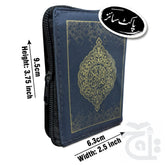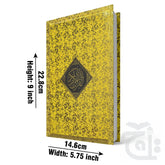



The Qaida Bughdadi with Para 30 Tajwidi is a foundational text used in Islamic education to teach proper pronunciation and recitation of the Quran, specifically focusing on the rules of Tajweed. Tajweed refers to the correct and precise articulation of Quranic Arabic, ensuring that every letter is pronounced correctly with its distinct characteristics.
This particular Qaida, named after its author Qari Bughdadi, is structured into 30 sections or paras (plural of para), each designed to systematically guide learners through the fundamentals of Tajweed. Starting from basic Arabic letters and their pronunciation, it progresses to more complex rules such as elongation (madd), nasalization (ghunnah), and stops (waqf).
The inclusion of Tajweed rules in the Qaida Bughdadi serves to uphold the integrity of Quranic recitation, as Tajweed is considered essential for preserving the divine message purity and beauty. Each section is meticulously organized to facilitate learning and mastery, providing exercises and examples that enable students to apply Tajweed principles effectively.
For Muslims, studying from the Qaida Bughdadi with Para 30 Tajwidi represents a step towards fulfilling the prophetic tradition of reciting the Quran correctly and melodiously, in accordance with the teachings of the Prophet Muhammad. It is a testament to the importance placed on preserving the Quran authenticity and spiritual resonance through disciplined study and adherence to Tajweed principles.
This particular Qaida, named after its author Qari Bughdadi, is structured into 30 sections or paras (plural of para), each designed to systematically guide learners through the fundamentals of Tajweed. Starting from basic Arabic letters and their pronunciation, it progresses to more complex rules such as elongation (madd), nasalization (ghunnah), and stops (waqf).
The inclusion of Tajweed rules in the Qaida Bughdadi serves to uphold the integrity of Quranic recitation, as Tajweed is considered essential for preserving the divine message purity and beauty. Each section is meticulously organized to facilitate learning and mastery, providing exercises and examples that enable students to apply Tajweed principles effectively.
For Muslims, studying from the Qaida Bughdadi with Para 30 Tajwidi represents a step towards fulfilling the prophetic tradition of reciting the Quran correctly and melodiously, in accordance with the teachings of the Prophet Muhammad. It is a testament to the importance placed on preserving the Quran authenticity and spiritual resonance through disciplined study and adherence to Tajweed principles.
- Choosing a selection results in a full page refresh.





















